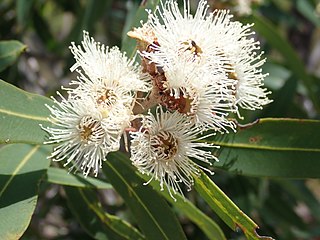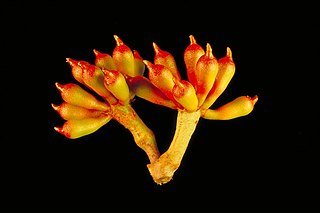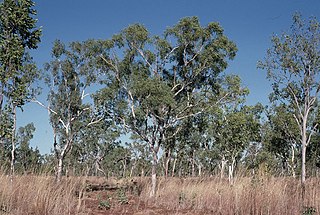
Angophora costata, commonly known as Sydney red gum or smooth-barked apple, is a species of medium-sized to tall tree that is endemic to eastern Australia. It has smooth bark, lance-shaped leaves arranged in opposite pairs, flower buds usually in groups of three, white or creamy white flowers and ribbed, oval or bell-shaped fruit.

Eucalyptus viridis, commonly known as the green mallee, is a species of mallee or small tree that is endemic to south-eastern, continental Australia. It has rough fibrous or flaky bark on the lower trunk, smooth bark above, linear to narrow lance-shaped adult leaves, flower buds in groups of seven or nine, white flowers and cup-shaped fruit.

Angophora bakeri, commonly known as the narrow-leaved apple, is a species of tree that is endemic to New South Wales. It has rough, fibrous bark on the trunk and branches, lance-shaped adult leaves, flower buds in groups of three or seven, white or creamy white flowers and oval to cylindrical fruit.

Angophora bakeri subsp. crassifolia is a small, shrubby tree or mallee that is endemic to a small area of New South Wales. It has rough bark on the trunk and branches, thick, rigid lance-shaped leaves, flower buds in groups of three or seven, white or creamy white flowers and cup-shaped to barrel-shaped fruit. It is similar to subspecies bakeri, differing in its smaller habit, thick leaves and slightly larger fruit.

Angophora subvelutina, commonly known as the broad-leaved apple, is a species of tree that is endemic to eastern Australia. It has rough bark on the trunk and branches, lance-shaped to egg-shaped or elliptical adult leaves, flower buds in groups of three or seven, white or creamy white flowers and ribbed, cup-shaped fruit.
Corymbia hendersonii, commonly known as Henderson's bloodwood, is a species of tree that is endemic to Queensland. It has rough, tessellated bark on the trunk and branches, lance-shaped adult leaves, flower buds in groups of seven, creamy white flowers and urn-shaped to barrel-shaped fruit.

Angophora leiocarpa, commonly known as rusty gum, is a species of small to medium-sized tree that is endemic to eastern Australia. It has smooth bark on the trunk and branches, lance-shaped adult leaves, flower buds usually in groups of three, white or creamy white flowers and smooth barrel-shaped to cup-shaped fruit.
Angophora inopina, commonly known as the Charmhaven apple, is a species of small, often multi-stemmed tree that is endemic to the Central Coast of New South Wales. It has rough bark on the trunk and branches, lance-shaped adult leaves, flower buds in groups of three or seven, white or creamy white flowers and ribbed, cup-shaped fruit.

Angophora woodsiana, commonly known as smudgee, is a species of small to medium-sized tree that is endemic to eastern Australia. It has rough bark on the trunk and branches, lance-shaped or curved adult leaves, flower buds in groups of three or seven, white or creamy white flowers and ribbed, cup-shaped fruit.

Corymbia zygophylla, commonly known as the Broome bloodwood, is a species of small tree or a mallee that is endemic to Western Australia. It has rough, tessellated to fibrous bark on the trunk and branches, a crown of juvenile heart-shaped to lance-shaped, stem-clasping leaves, flower buds in groups of three or seven, white flowers and urn-shaped to shortened spherical fruit.

Eucalyptus tectifica, commonly known as Darwin box, or grey box, is a species of tree that is endemic to northern Australia. It has rough, fibrous or flaky bark on the trunk and branches, lance-shaped or curved adult leaves, flower buds usually in groups of seven, creamy white flowers and conical, cup-shaped or barrel-shaped fruit.

Eucalyptus tetrodonta, commonly known as Darwin stringybark or messmate, is a species of medium-sized to tall tree that is endemic to northern Australia. It has rough, stringy or fibrous bark on the trunk and branches, lance-shaped leaves arranged in opposite pairs, flowers buds in groups of three, whitish to cream-coloured flowers and cylindrical fruit.
Corymbia brachycarpa is a species of tree that is endemic to central Queensland. It has rough, tessellated bark on the trunk and branches, lance-shaped adult leaves, flower buds in groups of seven, creamy white flowers and urn-shaped to barrel-shaped fruit.

Eucalyptus tenuipes, known as the narrow-leaved white mahogany, is a species of small tree that is endemic to Queensland. It has rough, fibrous bark, narrow lance-shaped leaves arranged in opposite pairs, flower buds in group of eleven to twenty, white flowers and spherical to hemispherical fruit.

Eucalyptus distans, commonly known as the Katherine box, is a species of small tree that is endemic to northern parts of Australia. It has rough, fibrous grey bark, dull, narrow lance-shaped adult leaves, flower buds in groups of seven, creamy white flowers and cup-shaped to hemispherical or conical fruit.
Eucalyptus terrica is a species of small tree that is endemic to south-eastern Queensland. It has thin, rough, fibrous bark on the trunk and larger branches, smooth bark above, lance-shaped adult leaves, flower buds in groups of seven, white flowers and hemispherical fruit.
Angophora costata subsp. euryphylla is a species of medium-sized to large tree that is endemic to a restricted area of New South Wales. It has smooth bark, lance-shaped adult leaves, flower buds in groups of three, white or creamy white flowers and cylindrical to barrel-shaped fruit. It is similar to subspecies costata but has broader leaves and larger fruit.

Angophora robur, commonly known as the sandstone rough-barked apple or the broad-leaved sandstone apple, is a species of small tree that is endemic to a small area in New South Wales. It has rough, fibrous bark on the trunk and branches, lance-shaped to egg-shaped or oblong adult leaves, flower buds in groups of three or seven, white or creamy white flowers and cup-shaped to bell-shaped fruit.

Angophora bakeri subsp. bakeri, commonly known as narrow-leaved apple, is a small to medium-sized tree that is endemic to New South Wales. It has rough bark on the trunk and branches, flower buds in groups of three or seven, white or creamy white flowers and cup-shaped to barrel-shaped fruit.
Angophora costata subsp. costata is a species of medium-sized to large tree that is endemic to eastern Australia. It has smooth bark, lance-shaped adult leaves, flower buds in groups of three, white or creamy white flowers and cylindrical to barrel-shaped fruit. It is similar to subspecies costata but has narrower leaves and smaller fruit.















